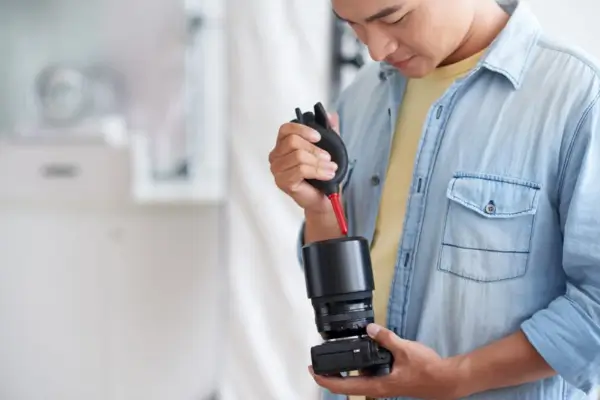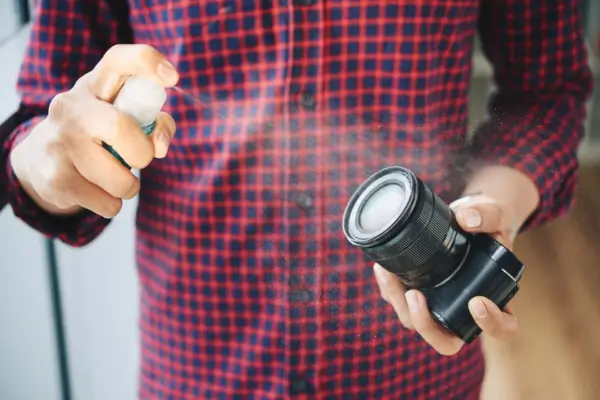As a photographer, your camera is one of your most valuable tools. Whether you’re a professional capturing stunning landscapes or an enthusiast documenting everyday moments, keeping your camera equipment clean and well-maintained is essential. Dirt, dust, and smudges can affect image quality, while improper storage or handling can lead to long-term damage.
Proper care not only ensures that your gear stays in optimal condition but also extends its lifespan and performance. A well-maintained camera produces sharper images, functions smoothly, and remains reliable for years. Neglecting maintenance, on the other hand, can lead to issues such as sensor dust spots, lens scratches, and even mechanical failures.
By adopting a regular cleaning and maintenance routine, you can protect your investment and continue capturing high-quality images without interruption. In this guide, we’ll walk you through the essential steps to properly clean and care for your camera equipment, helping you keep it in top shape for every shot.

Essential Cleaning Tools and Materials
To properly clean and maintain your camera equipment, it’s essential to use the right tools. Using incorrect materials can cause scratches, smudges, or even damage delicate components like the sensor and lens coatings. Here are the must-have cleaning tools every photographer should keep in their kit:
Soft Microfiber Cloths
Microfiber cloths are one of the safest and most effective tools for cleaning your camera lens and LCD screen. They gently remove dust, fingerprints, and smudges without scratching delicate surfaces. Always use a clean microfiber cloth and avoid applying excessive pressure while wiping.
Lens Cleaning Solution
A specialized lens cleaning solution is crucial for safely removing stubborn smudges, grease, and dirt. It is specifically formulated to avoid damaging the anti-reflective coating on camera lenses. To use it correctly, apply a small amount to a microfiber cloth or lens cleaning tissue—never directly on the lens—to prevent liquid from seeping into the edges.
Air Blower and Brush
Dust and debris can accumulate in small crevices, including the camera body, lens mount, and viewfinder. An air blower provides a gentle, chemical-free way to remove dust without touching the surface. A soft-bristle brush can also help sweep away particles from delicate areas, such as the lens edges or sensor chamber.
Sensor Cleaning Kit
Your camera sensor is one of the most sensitive parts of your equipment, and dust buildup can lead to visible spots in your photos. A sensor cleaning kit typically includes swabs and a specialized cleaning solution designed for safe sensor maintenance. It’s important to follow manufacturer guidelines or consult a professional if you’re unsure about cleaning the sensor yourself.
Lens Cleaning Wipes
Individually packaged lens cleaning wipes are a convenient option for quick maintenance on the go. These pre-moistened wipes are designed to remove smudges and dust without leaving streaks or residue. They’re especially useful for travel photographers who need a portable, hassle-free cleaning solution.
By keeping these essential tools in your camera bag, you can ensure that your equipment remains in top condition, allowing you to capture sharp, high-quality images with every shot.
Step-by-Step Guide to Cleaning Your Camer
Properly cleaning your camera is essential to ensure optimal performance and longevity. Below is a step-by-step guide to safely clean each component of your camera.
1. Cleaning the Camera Body
The camera body often accumulates dust, dirt, and fingerprints from regular handling. Keeping it clean helps maintain its functionality and appearance.
Removing Dust and Fingerprints
- Use a soft microfiber cloth to gently wipe the camera body, focusing on areas where fingerprints and smudges tend to accumulate.
- Avoid using household cleaning solutions, as they may damage the camera’s surface.
Using a Blower for Small Crevices
- A manual air blower is the safest way to remove dust from tight spaces, such as buttons, dials, and the lens mount.
- Never blow on the camera with your mouth, as moisture from your breath can cause damage.
2. Cleaning the Camera Lens
Since the lens directly impacts image quality, keeping it free of dust, smudges, and scratches is crucial.
Proper Way to Wipe the Lens
- Use a lens cleaning wipe or a microfiber cloth with a small amount of lens cleaning solution.
- Wipe in a circular motion, starting from the center and moving outward to avoid streaks.
Avoiding Scratches and Smudges
- Always store your lens with a lens cap when not in use.
- Never use rough materials like paper towels or clothing, as they can leave scratches.
- If you frequently shoot in dusty environments, consider using a UV filter to protect the lens.
3. Cleaning the Camera Sensor
A dirty sensor can result in visible spots on your images, especially in bright areas like the sky.
When to Clean the Sensor
- If you notice dark spots in your photos that remain in the same position regardless of the lens used, it’s a sign of sensor dust.
- Sensor cleaning should be done sparingly to avoid accidental damage.
DIY vs. Professional Cleaning
- For minor dust removal, use an air blower (never compressed air).
- If deeper cleaning is needed, a sensor cleaning kit with swabs and cleaning fluid is an option, but it requires a steady hand.
- If you’re unsure or uncomfortable cleaning the sensor yourself, take your camera to a professional service center to avoid damage.
By following these steps, you can keep your camera in top condition, ensuring sharp and clear images every time you shoot.

Maintenance Tips for Long-Lasting Camera Equipment
Proper maintenance is key to ensuring your camera equipment stays in excellent condition for years to come. By following these essential tips, you can prevent unnecessary wear and tear while maximizing the performance of your gear.
Storing Your Camera Properly
When not in use, always store your camera in a cool, dry place. Avoid exposing it to direct sunlight, extreme temperatures, or high humidity, as these factors can damage sensitive components. Consider using a dedicated storage case or a camera bag with padded compartments to prevent accidental impacts and scratches. If you’re storing your camera for an extended period, remove the battery to prevent leakage and potential damage.
Protecting Equipment from Humidity and Dust
Moisture and dust are two of the biggest threats to your camera equipment. High humidity can lead to mold and fungus growth on lenses and internal components, while dust particles can cause performance issues. To protect your gear, store it with silica gel packs or in a dehumidifying cabinet to absorb excess moisture. Regularly wipe down the exterior with a microfiber cloth and use an air blower to remove dust from hard-to-reach areas.
Using Lens Caps and Camera Bags
A simple yet effective way to extend the lifespan of your camera gear is to always use lens caps and a protective camera bag. Lens caps shield your lenses from scratches, smudges, and dust, preserving image quality. When transporting your camera, a high-quality, padded camera bag provides additional protection from shocks, bumps, and environmental elements. If you’re traveling, consider using waterproof or weather-sealed bags for extra security.
Regular Firmware Updates
Keeping your camera’s firmware up to date ensures that you benefit from the latest performance improvements, bug fixes, and new features released by the manufacturer. Many camera brands provide firmware updates that enhance autofocus accuracy, improve battery efficiency, and fix software glitches. To check for updates, visit the manufacturer’s official website, download the latest firmware, and follow the installation instructions carefully.
By implementing these maintenance habits, you can significantly extend the life of your camera equipment and ensure it continues to perform at its best. Regular care and proper storage not only protect your investment but also help you capture stunning images with confidence.

Common Mistakes to Avoid
When cleaning and maintaining your camera equipment, it’s essential to be cautious. Even small mistakes can cause long-term damage to your gear. Here are some common errors to avoid:
Using Rough Cloths or Tissues
One of the most common mistakes photographers make is using rough or abrasive materials, such as paper towels or tissues, to clean their camera lenses or screens. These can scratch the delicate surface of your lens or camera body, leading to permanent damage. Always use a soft microfiber cloth designed specifically for cleaning camera gear. Microfiber is gentle yet effective, ensuring that your equipment remains in pristine condition.
Applying Too Much Liquid Cleaner
Another mistake is applying too much liquid cleaner, especially on the lens or sensor. Excess cleaner can seep into the edges and cause streaks, dust buildup, or even damage the internal components of your camera. Always apply cleaner to the cloth first—never directly onto the lens or sensor—and use it sparingly. A few drops are usually more than enough to clean the surface thoroughly without causing any harm.
Touching the Sensor Without Proper Tools
The camera’s sensor is one of the most sensitive components, and touching it with your fingers or improper tools can lead to smudges, dirt, or even scratches. If you’re planning to clean the sensor, always use a professional sensor cleaning kit or take your camera to a certified technician for cleaning. Never attempt to clean the sensor with your bare hands or household items, as these could cause irreversible damage to your gear.
By avoiding these common mistakes, you can ensure that your camera equipment stays clean and in optimal working condition for years to come.
Conclusion
In summary, properly cleaning and maintaining your camera equipment is essential for ensuring its longevity and optimal performance. Regularly cleaning your camera body, lenses, and sensor with the right tools—such as microfiber cloths, air blowers, and lens cleaning solutions—will help prevent dust, dirt, and smudges from interfering with your shots. Additionally, storing your gear in a safe, dry place and performing routine checks will keep your camera functioning at its best for years to come.
Remember, camera maintenance doesn’t have to be a complicated task. By making cleaning a regular habit and following these simple steps, you can protect your investment and avoid costly repairs down the road. Take the time to care for your equipment, and it will continue to serve you in capturing stunning images and moments.
